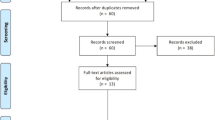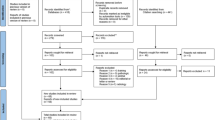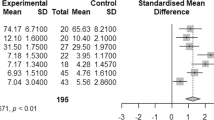Abstract
Purpose
The critical literature review investigates the extent to which the current evidence supports that three-dimensional printing (3DP) could play an important role in human anatomy education.
Methods
PubMed, ERIC, and Cochrane databases were searched for papers dealing with the outcomes of 3DP implementation in human undergraduate anatomy education. The following data were extracted from each paper: authors, year of publication, type of study (comparative or not), number of participants, level of outcome according to Kirkpatrick hierarchy, influence of 3DP on acquisition of anatomical knowledge and skills, as well as perceptions about the 3DP use in anatomy teaching.
Results
Eight papers were eligible for analysis. All of them comprised comparison of 3DP with other anatomy teaching tools. Two papers evaluated only students’ perceptions about 3DP, while six papers explored its impact on students’ knowledge. The 3DP was statistically significantly superior to two-dimensional images in terms of the investigated parameters. However, comparison between 3DP and cadavers’ dissection by students did not take place in any study.
Conclusion
The 3DP implementation in anatomy education showed promising outcomes. However, the lack of studies which compared the educational effectiveness of 3DP with that of cadavers’ dissection is highlighted. It seems that 3DP could certainly be used as an adjunct to cadavers’ dissection. Further research could clarify if 3DP could obtain a more prominent role in anatomy pedagogy compared to other anatomy teaching modalities.
Similar content being viewed by others
References
Alayón D (2018) The 10 types of 3D printing technology. www.medium.com. Accessed 21 Mar 2020
Arraez-Aybar L-A, Casado-Morales MI, Castano-Collado G (2004) Anxiety and dissection of the human cadaver: an unsolvable relationship? Anat Rec B New Anat 279(1):16–23. https://doi.org/10.1002/ar.b.20022
Backhouse S, Taylor D, Armitage JA (2019) Is this mine to keep? Three-dimensional printing enables active, personalized learning in anatomy. Anat Sci Educ 12(5):518–528. https://doi.org/10.1002/ase.1840
Baguley R (2017) 3D printing materials: the pros and cons of each type. www.tomsguide.com. Accessed 21 Mar 2020
Bannon R, Parihar S, Skarparis Y, Varsou O, Cezayirli E (2018) 3D printing the pterygopalatine fossa: a negative space model of a complex structure. Surg Radiol Anat 40(2):185–191. https://doi.org/10.1007/s00276-017-1916-x
Bartikian M, Ferreira A, Gonçalves-Ferreira A, Neto LL (2019) 3D printing anatomical models of head bones. Surg Radiol Anat 41(10):1205–1209. https://doi.org/10.1007/s00276-018-2148-4
Boeckers A, Brinkmann A, Jerg-Bretzke L, Lamp C, Traue HC, Boeckers TM (2010) How can we deal with mental distress in the dissection room? An evaluation of the need for psychological support. Ann Anat 192(6):366–372. https://doi.org/10.1016/j.aanat.2010.08.002
Chen S, Pan Z, Wu Y, Gu Z, Li M, Liang Z, Zhu H, Yao Y, Shui W, Shen Z, Zhao J, Pan H (2017) The role of three-dimensional printed models of skull in anatomy education: a randomized controlled trial. Sci Rep 7(1):575. https://doi.org/10.1038/s41598-017-00647-1
Fasel JH, Aguiar D, Kiss-Bodolay D, Montet X, Kalangos A, Stimec BV, Ratib O (2016) Adapting anatomy teaching to surgical trends: a combination of classical dissection, medical imaging, and 3D-printing technologies. Surg Radiol Anat 38(3):361–367. https://doi.org/10.1007/s00276-015-1588-3
Ganguli A, Pagan-Diaz GJ, Grant L, Cvetkovic C, Bramlet M, Vozenilek J, Kesavadas T, Bashir R (2018) 3D printing for preoperative planning and surgical training: a review. Biomed Microdevices 20(3):65. https://doi.org/10.1007/s10544-018-0301-9
Garas M, Vaccarezza M, Newland G, McVay-Doornbusch K, Hasani J (2018) 3D- Printed specimens as a valuable tool in anatomy education: a pilot study. Ann Anat 219:57–64. https://doi.org/10.1016/j.aanat.2018.05.006
Govsa F, Ozer MA, Sirinturk S, Eraslan C, Alagoz AK (2017) Creating vascular models by postprocessing computed tomography angiography images: a guide for anatomical education. Surg Radiol Anat 39(8):905–910. https://doi.org/10.1007/s00276-017-1822-2
Hammick M (2000) Interprofessional education: evidence from the past to guide the future. Med Teach 22(5):461–467. https://doi.org/10.1080/01421590050110713
Kirkpatrick DL (1998) Evaluating training programs: the four levels, 2nd edn. Berrett-Koehler, San Francisco, pp 1–320
Kong X, Nie L, Zhang H, Wang Z, Ye Q, Tang L, Huang W, Li J (2016) Do 3D printing models improve anatomical teaching about hepatic segments to medical students? A randomized controlled study. World J Surg 40(8):1969–1976. https://doi.org/10.1007/s00268-016-3541-y
Kong X, Nie L, Zhang H, Wang Z, Ye Q, Tang L, Li J, Huang W (2016) Do three-dimensional visualization and three-dimensional printing improve hepatic segment anatomy teaching? A randomized controlled study. J Surg Educ 73(2):264–269. https://doi.org/10.1016/j.jsurg.2015.10.002
Lim KH, Loo ZY, Goldie SJ, Adams JW, McMenamin PG (2016) Use of 3D printed models in medical education: a randomized control trial comparing 3D prints versus cadaveric materials for learning external cardiac anatomy. Anat Sci Educ 9(3):213–221. https://doi.org/10.1002/ase.1573
McMenamin PG, Quayle MR, McHenry CR, Adams JW (2014) The production of anatomical teaching resources using three-dimensional (3D) printing technology. Anat Sci Educ 7(6):479–486. https://doi.org/10.1002/ase.1475
Mogali SR, Yeong WY, Tan HKJ, Tan GJS, Abrahams PH, Zary N, Low-Beer N, Ferenczi MA (2018) Evaluation by medical students of the educational value of multimaterial and multi-colored three-dimensional printed models of the upper limb for anatomical education. Anat Sci Educ 11(1):54–64. https://doi.org/10.1002/ase.1703
Penney JC (1985) Reactions of medical students to dissection. J Med Educ 60:58–60. https://doi.org/10.1097/00001888-198501000-00010
Sinav A, Ambron R (2004) Interactive web-based programs to teach functional anatomy: the pterygopalatine fossa. Anat Rec B New Anat 279(1):4–8. https://doi.org/10.1002/ar.b.20021
Smith CF, Tollemache N, Covill D, Johnston M (2018) Take away body parts! An investigation into the use of 3D-printed anatomical models in undergraduate anatomy education. Anat Sci Educ 11(1):44–53. https://doi.org/10.1002/ase.1718
Author information
Authors and Affiliations
Corresponding author
Ethics declarations
Conflict of interest
The authors declare that they have no conflict of interest.
Additional information
Publisher's Note
Springer Nature remains neutral with regard to jurisdictional claims in published maps and institutional affiliations.
Rights and permissions
About this article
Cite this article
Chytas, D., Johnson, E.O., Piagkou, M. et al. Three-dimensional printing in anatomy teaching: current evidence. Surg Radiol Anat 42, 835–841 (2020). https://doi.org/10.1007/s00276-020-02470-2
Received:
Accepted:
Published:
Issue Date:
DOI: https://doi.org/10.1007/s00276-020-02470-2




